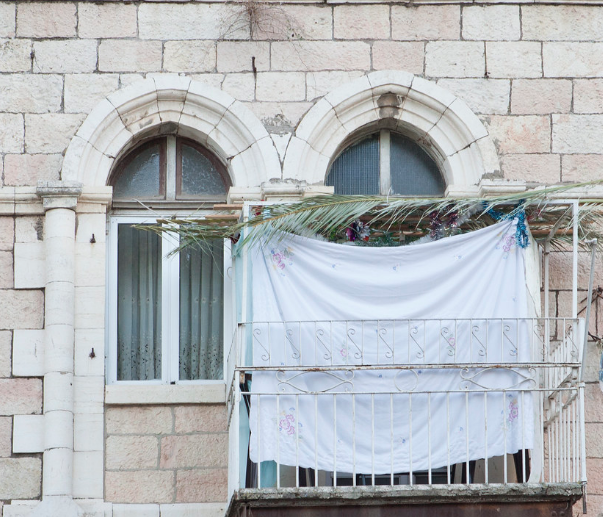
Turning Sukkot Inside Out
As Sukkot, my favorite holiday, drew nearer, I began to wonder about the role of my balcony in my Sukkot celebration. It seemed counterintuitive to build a Sukkah on the balcony–– though it was my only “outdoor space”—since stars could be seen only by looking out, not up, as a traditional Sukkah calls for. I could hang boards or sheets from the roof, but then I would have an enclosed space, with no room to look upon the world outside. I decided to leave my balcony be, but decorated it with gourds, garlands of paper, and autumn leaves hung from bits of string. I crisscrossed string lights in the interior of the roof like a pattern of symmetrical stars. I placed chairs and cushions around the edge, a stained picnic blanket in the center as a makeshift tablecloth, and propped open the screen door into my apartment as a symbolic gesture of welcome. (A gesture my roommate quickly disavowed, as it would let bugs in.)
Sukkot is a holiday to celebrate the harvest, and though I was three stories above the earth, I celebrated my own harvest: a place to live, groceries in my fridge, a job, quiet neighbors, a laundromat down the street. Sukkot is a time to relish in the joy of community, to invite guests and strangers as a part of the family. I knew a total of five people in Philadelphia, only one of them Jewish, so I invited them over via Facebook to a “Sukkot Harvest Dinner,” with the promise that I would cook for this small crowd whatever I could on a limited budget and not enough plates. I told them all to bring wine, and their own forks.
For a holiday that is already unconventional in many regards—making the comforts of home new again by erecting a temporary shelter and sleeping in it in the unpredictable October weather, celebrating for eight days straight, dipping challah in honey like nobody’s business—my version did not seem too heinous. After all, I lived in a bustling city, and hardly anyone around me had a backyard with space for a Sukkah to spare.
Yet on the night of my Sukkot dinner, I glanced at my neighbor’s yard, an overgrown concrete space with bricks and weeds in a tango around the edges. I looked at my balcony-Sukkah, at the lights and ornaments, at the passerby staring adamantly at the sidewalk in front of him. My version of Sukkot, my inside-out Sukkah, struck me as a bit pathetic. A Sukkot celebration I was forced into because there were no other options. Past my neighbor’s roof, I saw an early evening star glinting on the horizon. I suddenly thought—what if every star I’ve seen from this spot has been a low-flying plane? The thought is laughable and fills me with relief. Balcony, Sukkah, star, plane—what does it matter?
This is what being a 21st century Jew is—I have adapted to customs crafted and altered to circumstance over hundreds and thousands of years. I was just another blip on the calendar of tradition, a small figure on a balcony-Sukkah adorned with lights and soon to be filled with the laughter of friends.
Shoshana Lovett-Graff works to bridge the space between technology and Jewish practice. She is interested in place-based identity, ritual creation, and histories too close for comfort. She currently writes, cooks, and lives in Philadelphia, PA.



